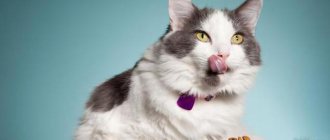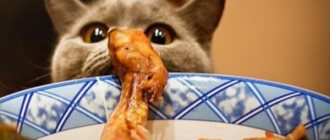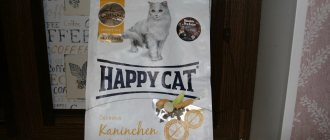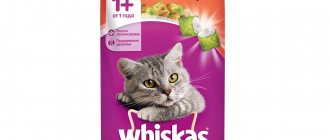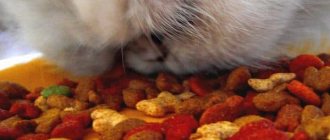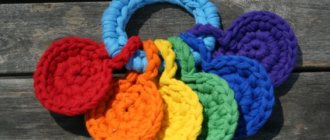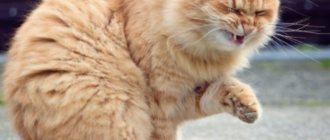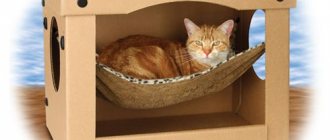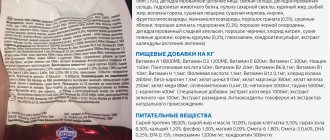For full development, a cat needs proteins, vitamins, fatty acids, minerals, and enzymes. Some cat owners buy food themselves and prepare natural food for their pets. It is important that free cat food is balanced and nutritious. For many, lack of time and lack of necessary knowledge make preparing food practically impossible. It’s easier for them to spend money on ready-made food.
How, when you come to a pet store, not to get lost in the variety of types of food and its manufacturers? How to choose from this variety what is useful and of high quality? And also what is cat food made from? The answer to these questions can be found in this article.
What types of food are there?
Despite all the diversity, several groups can be distinguished. These are natural, dry, wet and canned cat foods.
Natural food
It is important to know that feeding an animal foods that humans eat is very harmful. Many well-known veterinarians call meat and fish the best food for cats. But is this enough? No. Periodically, the cat should receive mineral and vitamin supplements. Still, natural products are unlikely to fully replace anything.
Veal, lean lamb, rabbit meat - they are the main suppliers of protein for the animal. Pork is not the best food for cats; its consumption should be minimal and boiled. Poultry meat should be pre-heat treated. It is useful to periodically feed your pet beef liver (an excellent source of vitamins A, B, D, H). Although fish is an important food for cats, we should not forget about the danger of helminth infection. This means that boiled fish is safer.
Cats are known to be addicted to milk, but it is practically not absorbed by the cat’s body. But kefir, sour cream, cottage cheese, cheeses are useful. You should also not forget about products of plant origin: oatmeal, rice, and semolina should be present in the diet of a four-legged pet. As well as vegetables: carrots, greens, cauliflower, boiled and pureed, will significantly complement high-calorie food for cats and kittens. Read more about feeding cats natural food here.
Canned food
This is a delicacy for every cat. According to owners, canned food is an excellent substitute for natural products. Sealed packaging significantly increases shelf life and saves the owner’s time. The high humidity that characterizes such a product (such as One cat food, for example) replenishes the cat's need for liquid. This is especially true if the animal drinks little. It is worth giving your pet as much food as he will eat at a time; The remaining food should be transferred to a glass container and put in the refrigerator.
Wet food
Something between dry food and canned food. Tasty pieces of meat or fish in sauce, included in cat food with a moisture content of about 35% (this is about two times lower than the moisture content in canned food), will appeal to your pet. One bag of Bilanx cat food, for example, is designed for one feeding. If the package is larger, then the remaining product should be stored in a cool place, since pieces dry out quickly in the open air, which leads to a loss of taste and nutritional properties of the product.
Among the recognized leaders in this product segment, according to numerous reviews from customers and veterinarians, is Wellkiss cat food, which can be purchased at any pet store.
Dry food
Many believe that it is useful not only as food itself, but also for the animal’s teeth (when biting, the pet’s teeth are cleared of plaque), and for the prevention of urolithiasis. The indisputable advantage of this product is that it can be left in a bowl for a long time (ideal when the owners are away for several days) - it does not dry out or spoil.
Veterinarians usually do not object to this choice of food for cats, but they recommend using products from well-known companies (optionally Berkeley cat food or Applaws cat food) that have proven themselves well in this market. Tomcat cat food also deservedly belongs to them: it contains no preservatives or by-products.
Dry foods are usually rich in protein (Nutram cat food contains approximately 50% protein); contain few carbohydrates (up to 7%). When using dry food, you need to provide your pet with a constant and sufficient amount of fresh water. Although this type of food does not spoil for a long time, it is better to keep it in closed, airtight containers to preserve its nutritional and taste qualities.
Is it possible to make food with your own hands: 5 stages of preparation
You can make an analogue of dry food at home, but you should not prepare large batches of food. Without the addition of preservatives, drugs that inhibit the growth of molds and bacteria, food cannot be stored for months, like the industrial version.
Meat (fish) food
To prepare you will need:
- Meat – 2 kg. Pork is contraindicated for cats; it is better to take beef, veal, and turkey. Offal products are good (liver, kidneys, lung, heart, cleaned stomachs). You can use sea fish (hake fillet, pollock, capelin, blue whiting, anchovy). It is not advisable to mix meat and fish in one serving; it is permissible to use different varieties of the same type of product.
- Vegetables – 0.5 kg. (carrots, beets, zucchini, broccoli).
- Egg – 3 pcs.
- Olive oil – 3-4 tablespoons.
- Rice (buckwheat) – 0.5 cups of the finished product.
Meat (fish) is separated from the bones, vegetables are washed and peeled. The solid components, the porridge, are passed through a meat grinder twice and crushed with a blender until pureed. Add raw eggs, cottage cheese, butter. Mix thoroughly.
Salt, pepper, spices, onions, and garlic are strictly prohibited from being added to the mixture. On the Internet you can find recipes for producing dry cat food based on canned fish. You should not put them into practice; human food contains spices, salt, and an abundance of fats that are harmful to cats.
Be sure to read:
Spiders for cats: what they are, composition, types, better canned food, how to choose, pros and cons
The baking sheet is greased with vegetable oil or covered with parchment or foil. Using a cake decorating bag, squeeze out sausages 1.5-2 fingers thick over the entire length of the sheet. Dry in the oven over low heat until it becomes breadcrumbs.
The finished sticks are crushed into small pieces. The food is stored in the refrigerator, packaged in bags for daily portions.
Feed classes
The main differences between feeds are the composition, degree of usefulness and, of course, price. There are economy, middle and premium classes.
Economy class. The food has a relatively low nutritional value and is intended to satisfy hunger. They contain a lot of preservatives, flavor enhancers, and other artificial additives; on the contrary, there is little meat (it is replaced by offal). The differences in food do not depend on fillers, but on flavoring additives. Veterinarians recommend not feeding these products to pets on a regular basis, since their digestibility ranges from 60 to 65%. As an option, use mixed feeding (combine dry food with natural food). This class of products includes cat food Whiskas, Darling, Meow and others.
Middle class. Made from higher quality products. Contains less soy and grains than economy class products. Feed in this category is more nutritious; therefore, a smaller amount is required to satiate the animal.
Premium and super-premium class. Expensive food, but good for health. There are not many by-products in them and they are of higher quality. Their digestibility is 70-75%. One of the leaders in this class is Aplaus cat food - a worthy replacement for natural food. Trainer food for cats and kittens was highly appreciated by experts. To compare cat food composition, it is important to carefully read the contents of the food you purchase. Read more about premium dry food.
"Felix" (in bags)
What is this brand of cat food made from? This is economy food. It contains meat and its processed products (4% chicken, 4% lamb). However, what kind of meat is included and how much of it is unknown. In addition, there is a vegetable protein extract, fish and its products, minerals, dyes, sugars, and vitamins.
What is this brand of cat food made from? This is economy food. It contains meat and its processed products (4% chicken, 4% lamb). However, what kind of meat is included and how much of it is unknown. In addition, there is a vegetable protein extract, fish and its products, minerals, dyes, sugars, and vitamins.
What food is suitable for sterilized cats?
Alas, for a number of reasons, owners sometimes have to resort to sterilization surgery. This leads to significant changes in the physiology and lifestyle of the animal. Hormonal levels change, the desire to participate in mating games disappears. The attitude towards food is also undergoing changes - now this is the main pleasure for the pet. This often results in rapid weight gain.
In this situation, the owner needs to be able to distract the cat from eating. It would be nice to spend more time with the animal and keep it busy with active games. If your weight continues to increase, you will have to switch to low-calorie foods. What food will be optimal? If before the operation it consisted of natural food, you can simply adjust it a little.
The diet should be:
- poultry, beef;
- milk porridge;
- vegetables;
- offal;
- fermented milk products.
If ready-made food was used before the operation, then again there is no need to make drastic changes to the nutritional structure. The animal can continue to eat ready-made food, only with a significant amendment: it should switch to food designed specifically for sterilized cats. Manufacturers are constantly expanding the range of this group, especially for premium and super-premium food. One of them, Nutram cat food, has earned many accolades.
It is better to purchase specialized food at pet stores. In them, an experienced sales consultant will help you choose a special dietary food for a sterilized cat, taking into account the age, weight, and physiology of the pet. Such food will prevent urolithiasis and maintain normal weight. The already mentioned Nutram food for cats can be selected taking into account the characteristics of the animal. Read also about Royal Canin food for sterilized cats.
Where is the truth?
It’s interesting that both cat food with pompous names and the most common human food, such as pasta, sausages, etc. The name of food these days is not as important as its ingredients. But the composition of any product can be found on the packaging. True, the ingredients listed there are not always clear to everyone.
The list of products is in descending order, but not all of their names mean what is written. For example, meat, at best, means that the product has been dried and ground into powder. Then, depending on the final goal of the product - “crispy pads” or “tender pulp”, appropriate additives are added - emulsifiers, thickeners, etc.
To attract the cat's attention and develop an appetite, flavorings are needed. They use extracts of various plants (rosemary, fennel, chamomile, ginger, etc.)
Features of feeding a kitten
Naturally, the food of a small creature should be different from that of an adult; its diet must include whole milk and kefir.
But this will not be enough for full development: a growing body really needs vitamins (their deficiency can be perfectly compensated by vegetables) and calcium (it is perfectly absorbed from cottage cheese). An excellent product is egg yolks, which can be given two to three times a week. Canadian cat food "Acana" can be a complete food for a kitten, which will help it grow healthy and strong.
Up to two months, a small animal should be fed five to six times a day. Then you should accustom him to four meals a day, and from the age of six months, feeding three times a day will be quite sufficient. An eight-month-old kitten, like an adult cat, needs to be fed twice a day.
Main Ingredients
- "Meat" . Mammalian muscle tissue, which can naturally include fat, tendons, cartilage, blood vessels, and even pieces of skin. Since the heart and diaphragm are also muscles, they are also considered “meat”. “Meat” for pet food is obtained using the mechanical deboning method: machines separate it from the bones and grind it into minced meat, as for sausages.
By default, “meat” means beef, pork, lamb, or goat. The manufacturer may or may not specify this. But if the composition uses any type of “meat” other than those listed above (for example, rabbit), this must be indicated on the packaging. Poultry or fish cannot be called "meat".
- "Meat by-products" . Edible parts of mammals that are not muscle tissue. For example, liver, kidneys or tripe. The udder and lungs are considered inedible for humans, but acceptable for domestic animals.
- "Bird" . This term should mean the edible parts of birds - everything except feathers, entrails, legs and heads. Skin and bones are also “birds”. They are ground together with meat, since for the production of feed it is not the fillet that is used, but the less “profitable” parts of the carcass - the back, neck, etc.
The ground bones in the poultry ingredient can be a good source of calcium. The manufacturer can even indicate on the packaging the specific type of poultry used - chicken, turkey , etc.
- "Poultry by-products" . But these are just ground heads, legs and even intestines (in theory, cleaned of fecal matter)
The “offal” also includes the completely edible heart, stomach and liver. In most inexpensive cat foods, you most likely will not find ingredients such as just “meat” or just “poultry”. At best, there will be “by-products” or highly processed substances, which we will discuss below.
Nutrition for a pregnant cat
The diet of a pregnant cat also requires some changes. In the first two weeks, you should increase the amount of food you eat by about ten percent. This is achieved by switching to four meals a day.
In the period from three to seven weeks, the amount of food eaten should be increased by 50%, and the expectant mother is fed not only more often, but also the portions are increased.
After seven weeks, the cat cannot eat much, so she needs to be fed even more often. When a pregnant woman stops eating altogether, it means that kittens will appear any minute.
What should you feed your cat during this important period? In addition to vitamins and minerals, she especially needs proteins. They should be the main product in the diet. This is boiled beef (you can add rabbit, chicken, turkey). It is also important to have enough calcium in your diet. It can be cottage cheese, kefir, egg yolk. These foods can be given every day. Well, cereals and vegetables will still come in handy.
If previously the animal was fed with ready-made food, then it would be wise, after consulting with a veterinarian, to select a product (Probalance cat food, for example) designed specifically for pregnant women. In this case, there is no need to give vitamins and minerals. Natural cat food, which is not difficult to find on the shelves of specialized stores, will fully provide everything you need.
Industrial feed composition tables
The tables list all possible components and evaluate them; those that may be harmful to the cat’s health are separately noted.
Meat ingredients
| Ingredient | Allowed and prohibited components | |
| Meat* | Beef pulp, fat, cartilage, heart, tongue, etc. | |
| Meat by-products | Entrails, bones and blood. There should be no horns, teeth, hooves, fur. | |
| Bird | Carcasses with bones and skin. | |
| Poultry by-products | Bird entrails, bones and blood. No - feathers. | |
| Flour | meat | Dried and ground meat and offal. Cannot contain bones, blood, fur, feathers, hooves, horns, etc. |
| meat and bone | Dried and ground meat, bones and offal. Phosphorus content – not less than 4%, calcium – 8.8%. The protein content (digested with pepsin) is no more than 12%. | |
| from offal | Dried and ground meat and offal into flour. | |
| Hydrolyzed protein | Protein broken down into amino acids. According to manufacturers, it does not cause allergies in cats. The nutritional value and safety for the animal are questionable. | |
| Bacon | Natural flavor. | |
| Bouillon | A decoction of meat and bones (the label should indicate what it is from - pork, fish, etc.). Typically includes monosodium glutamate. A good alternative to water to increase feed moisture. | |
| Fat | beef | Natural attractant, source of Omega-6 acids. |
| chicken | ||
| Chicken oil – rendered internal fat | ||
| Skim milk | Typically used only in kitten foods. Contains protein and lactose, which are not digestible by adult cats. | |
| Porcine plasma | Low quality protein from: | blood. |
| Egg powder | crushed and dried eggs. | |
*Meat - beef, pork, goats, sheep - do not require the type of animal to be indicated on the label. Poultry, venison, buffalo and others - species must be specified.
Cereal ingredients
| Fillers forming feed granules | ||
| Ingredient | Is the source, properties | |
| Corn starch | Carbohydrates | |
| Flour | corn | Carbohydrates and plant proteins. |
| oatmeal | ||
| wheat | ||
| rice made from polished white rice | ||
| Wheat gluten | ||
| Beer rice | In high quantities it destroys taurine. | |
| Tapioca | In the form of starch and flour. Low protein, high carbohydrates. | |
| Other components | ||
| Pea protein | Low quality vegetable protein. | |
| Corn gluten | ||
| Pea flour | Crushed fried peas improve the digestibility of pea flour. | |
| Dark rice | Carbohydrates, proteins, vitamins, minerals. In high quantities it destroys taurine. | |
| Barley | Source of dietary fiber. | |
Vegetables and fruits, greens
| Fillers forming feed granules | ||
| Ingredient | Is the source, properties | |
| Sweet potato | Carbohydrates and dietary fiber. | |
| Blackberry | Dietary fiber. | |
| Potato starch | Carbohydrates. | |
| Other Ingredients | ||
| Carrot | Dietary fiber. | |
| Plantain | ||
| Pumpkin | ||
| Zucchini | ||
| Blueberry | Vitamins and antioxidants, acidifier. | |
| Cranberry | Vitamins, acidifier. | |
| Rosemary | Natural preservative. | |
| Blueberry extract | ||
| Garlic | ||
| Alfalfa | Green sprouts, low quality vegetable protein. | |
| Molasses | Sugarcane waste, calcium and betaine. | |
| Ginger | Normalization of digestion | Removing hairballs. |
| Parsley | Breath freshening. | |
| Thyme | In minimal quantities, toxic, antiparasitic agents. | |
| Garlic | ||
| Yucca | Eliminates and masks unpleasant odors of granules and feces. | |
Lactobacilli
| Lactobacillus acidophilus | Probiotics are substances that contain live bacteria from the body’s own microflora. |
| Bacillus subtilis | |
| Bifidobacterium Thermophilum | |
| Enterococcus Faecium | |
| Bifidobacterium Longum |
Yeast, fiber
| Fillers forming feed granules | |
| Ingredient | Is the source, properties |
| Tomato paste | Dietary fiber. |
| Cellulose | |
| Perilla | A mint type plant. Source of Omega-3 and Omega-6 fatty acids. In concentrated form it causes diarrhea. Considered toxic. Used only in feed produced in China, Korea and Japan. |
| Other components | |
| Chicory root extract | Inulin, prebiotic*. |
| MOS, FOS | |
| Peas and pod | Dietary fiber. |
| Oat bran | |
| Beet pulp and pulp | |
| Flax-seed | |
| Seeds, skin and pulp of tomatoes | Prebiotic. |
| Brewer's yeast | Low-quality vegetable protein, prebiotic*. |
| Rice bran | Dietary fiber in large quantities is destroyed by taurine. |
*Prebiotic is a growth stimulator of living bacteria of the body’s own microflora.
Vitamins and minerals
| Ingredient | Is the source, properties | |
| Iron proteinate | Gland. | |
| Amino acid chelate | cobalt | Amino acids and vitamin B12. |
| magnesium | Amino acids and magnesium. | |
| copper | Copper. | |
| zinc | Zinc. | |
| Yodat | potassium | Iodine and potassium. |
| calcium | Calcium. In minimal quantities it can cause thyroid dysfunction. | |
| Carbonate | calcium | Calcium. Prevents granules from sticking together. |
| cobalt | Vitamin B12. | |
| Sulfate | calcium | These elements. |
| gland | ||
| magnesium | ||
| manganese | ||
| copper | ||
| zinc | ||
| chondroitin | Prevents joint disease. | |
| Phosphate | dicalcium | Phosphorus and calcium. |
| calcium | ||
| tricalcium | + prevents granules from sticking together | |
| Sodium Selenite | Sodium. | |
| Zinc oxide | Zinc. | |
| Betaine anhydrous | Choline substitute. | |
| Sodium bisulfate | Vitamin K, acidifier. | |
| Thiamine mononitrate | B1. | |
| Pantothenate | calcium | B5, pantothenic acid. |
| calcium D | Synthetic pantothenic acid. | |
| Tocopherol | Natural preservative, vitamin E. | |
Dyes, preservatives, attractants
| Ingredient | Properties, characteristics | |
| Flavors | artificial | Synthetic additives with odors. |
| natural | Obtained from natural raw materials, such as fat. | |
| Ascorbic acid | Natural preservative. | |
| Gelatin | Low quality protein, collagen. | |
| Gum | Natural gelling and stabilizing agent. | |
| Caramel | Natural dye. | |
| Sodium | nitrite | Color stabilizer, carcinogen. |
| chloride | Natural preservative, stimulator of water consumption in animals. | |
| Red 3 | Dye, carcinogen. | |
| Ethylenediamine | Iodine. | |
*Attractant is a component that affects a cat’s taste buds, attracting it.
Taurine requirement
To form bile acids, cats need taurine, since animals are not able to use other amino acids for these purposes. Although taurine is synthesized by the liver from amino acids eaten in foods containing sulfur, this amount is not enough for the body. This means that taurine in cat food is necessary for the health of the animal. And since taurine is not included in plant products, your pet needs food with animal protein. The taurine included in Gourmet cat food will fully satisfy this need.
Preservatives
Of course, any feed contains substances that ensure long-term storage of the product. Possible preservatives include:
- ascorbic acid;
- benzoic acid,
- butylated hydroxyl anisole (BHA),
- butylated hydroxyl toluene (BHT),
- calcium ascorbate,
- lemon acid,
- ethoxyquin,
- potassium sorbate,
- sodium bisulfate,
- tocopherols.
It is the manufacturer's responsibility to indicate the preservative used.
- ascorbic acid;
- benzoic acid,
- butylated hydroxyl anisole (BHA),
- butylated hydroxyl toluene (BHT),
- calcium ascorbate,
- lemon acid,
- ethoxyquin,
- potassium sorbate,
- sodium bisulfate,
- tocopherols.
Choosing the right food
The inscription on the packaging “balanced, complete, optimal balance, nutritious” does not always serve as a guarantee of the quality of the product. The composition of the product must indicate the percentage of protein (minimum 25%), and not just its presence. The type of meat must also be indicated. It is optimal if the sources of protein in your food are at least two types of meat. Milk and egg whites are excellent components for the diet. It’s good if the share of by-products is no more than 10%.
Plant fibers (wheat, rice, oats, corn) in a complete feed should be, but not more than 25%. Important components of good food are vitamins B1, B2, B3, B5, K, H, E, C, as well as calcium, cobalt, copper, iron, ascorbic acid and the already mentioned taurine.
Not everyone has the specialized knowledge to select the best diet for a pet. So the chief nutritionist usually becomes a veterinarian. He will be able to choose the optimal diet for your pet.
Canned food - production and difference from dry food
Wet food is produced similarly to dry food, but instead of drying, the technology includes preservation of the semi-finished product.
The moisture content of canned cat foods - purees, stews, jelly, mousses and others - reaches eighty percent. It is important to know it in order to correctly determine the composition of other components, most importantly - proteins and fats.
For example, at 80% humidity, the can says 5% fiber content. By calculating this share from the remaining 20% of dry products, you can see that in fact its content is 25%. The same recalculation can determine the content of fats, proteins, and macroelements.
It’s a bad sign if the canned food label contains the words “flavors of.” This only means that the composition contains artificial flavors.
In developed countries, it is prohibited to write “all” on the label, which means that the product consists of 100% one component - meat, fish, etc. This is technologically impossible and is a trick of the manufacturer, a deception.
Cat's diet and nutritional needs
It is important to remember that a cat is a carnivore, a predator. Her body is not predisposed to digesting “human” food. Improper feeding of a cat with smoked, fried, salty, spicy and sweet foods can lead to serious diseases of the gastrointestinal tract, urinary tract and kidneys, liver, as well as metabolic disorders, says Natalya Malkova, scientific communication expert at Mars Petcare, veterinary - sanitary doctor, candidate of veterinary sciences.
— A cat’s diet must contain high-quality animal products. Meat and offal are the basis of a cat's nutritional needs, as they are rich in valuable proteins and vital amino acids, such as taurine and arginine. In addition to proteins, your pet’s body needs polyunsaturated fatty acids, especially arachidonic acid, which a cat can obtain exclusively from certain types of meat, offal, animal fat and fish.
— Also, high-quality complete food for cats must contain vegetables, grains, vegetable oils and a vitamin-mineral complex. In a cat’s diet, it is especially important to control the content of retinol (vitamin A) and niacin (vitamin B3), continues Natalya Malkova. “They prevent delayed growth and development of the animal, eye and skin diseases, improve the condition of the coat and help strengthen the immune system. Preferring to feed a cat from a common table, it is quite difficult to control the presence of all the necessary substances, even if the diet includes only fresh meat and spring water.
1900s - Pet food becomes popular
In the 1900s, pet food ceased to be a curiosity and became increasingly popular. In 1907 F.Kh. Bennett founded a company in New York that began producing Milk Bone dog biscuits. Later, after World War I, Ken-L-Ration introduced canned horse meat for dogs. Where do you think they got the raw materials for such food?
And finally, in the 1930s, the food revolution reached cats. It was at this time that the Gaines Food company opened the production of canned cat meat.
How to make wet food in bags?
Making wet cat food is an almost entirely robotic process. Raw materials that have passed all the necessary checks enter the processing line in frozen form. Why frozen? Due to the effect of low temperatures, the possibility of the development of pathogenic bacteria in the product is eliminated.
Huge industrial meat grinders grind the ingredients for future cat food, turning them into a homogeneous puree; vitamin and mineral supplements and vegetable oils are also mixed into it. At the same time, sauce for future meat pieces is being prepared on another line. Meat puree is turned into thin “sausages” by pressing through a special mold. Before slicing, the “sausages” undergo heat treatment so that the machine can easily cut them into small fragments.
Feed packaging process
The next step is mixing the meat pieces with the sauce and packing them into pouch packaging. Hermetically packaged food is sent to large industrial “pressure cookers” - autoclaves, where the sterilization process takes place under pressure and high temperatures. It is this heat treatment that makes it possible to ensure a long shelf life of the finished product in the most reliable way.
The completely cooled food is sent further to packaging equipment, where a special machine at lightning speed packs the spiders into cardboard boxes and sends them further to group packaging and wrapping in polyethylene stretch film. In this form, boxes of cat food are ready to leave the factory walls and hit store shelves.
